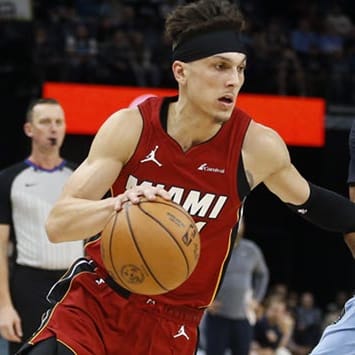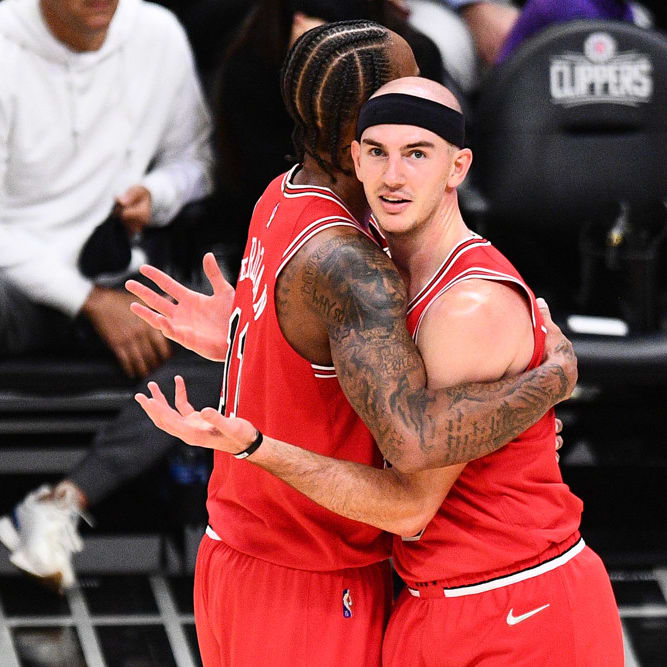This article is part of our NBA Injury Analysis series.
RotoWire injury expert Jeff Stotts takes an in-depth look at the key injuries impacting the fantasy basketball landscape.
Caris LeVert
The Nets' forward suffered a nasty leg injury last week when he fell to the court in Minnesota. Like Gordon Hayward's injury last season, LeVert's ankle was left grossly distorted, leaving spectators and teammates visibly shaken. The medical staffs for both teams sprung to action, quickly tending to LeVert's injury before taking him off the court on a stretcher. LeVert's ankle was then return to its normal position before he was then transported to a nearby hospital for further treatment and evaluation.
Fortunately, LeVert was able to travel back to New York with his teammates and met with team orthopedist Dr. Martin O'Malley, the same physician who performed LeVert's three previous foot surgeries. Dr. O'Malley's evaluation produced surprising, yet encouraging, results as it was determined the injury was not as significant as it looked and surgery would not be necessary.
To understand how that is even remotely possible, you have to consider the bony makeup of the foot and ankle. The ankle mortise is formed by the ends of the two lower leg bones, the tibia and the fibula. The two distal ends form a roof over another bone, the talus. The talus is first of the tarsus bones of the foot that make up the hindfoot and the midfoot. The talus sits atop the calcaneus (the heel bone) forming the talocalcaneal or subtalar joint.
When LeVert landed following
RotoWire injury expert Jeff Stotts takes an in-depth look at the key injuries impacting the fantasy basketball landscape.
Caris LeVert
The Nets' forward suffered a nasty leg injury last week when he fell to the court in Minnesota. Like Gordon Hayward's injury last season, LeVert's ankle was left grossly distorted, leaving spectators and teammates visibly shaken. The medical staffs for both teams sprung to action, quickly tending to LeVert's injury before taking him off the court on a stretcher. LeVert's ankle was then return to its normal position before he was then transported to a nearby hospital for further treatment and evaluation.
Fortunately, LeVert was able to travel back to New York with his teammates and met with team orthopedist Dr. Martin O'Malley, the same physician who performed LeVert's three previous foot surgeries. Dr. O'Malley's evaluation produced surprising, yet encouraging, results as it was determined the injury was not as significant as it looked and surgery would not be necessary.
To understand how that is even remotely possible, you have to consider the bony makeup of the foot and ankle. The ankle mortise is formed by the ends of the two lower leg bones, the tibia and the fibula. The two distal ends form a roof over another bone, the talus. The talus is first of the tarsus bones of the foot that make up the hindfoot and the midfoot. The talus sits atop the calcaneus (the heel bone) forming the talocalcaneal or subtalar joint.
When LeVert landed following his attempt to contest the shot of Minnesota's Josh Okogie, his right foot was violently forced into inversion. The resulting stress forced the subtalar joint out of alignment, bending the foot at a vicious angle. Given this mechanism of injury, the subtalar joint likely dislocated medially or inward. This direction of dislocation is actually advantageous as medial subtalar joint dislocations are less likely to be open or break through the skin. Furthermore, lateral dislocations are more commonly associated with fractures of the lower leg bones. While the injury was unsightly, things could have been much worse.
The favorable results were confirmed by Dr. O'Malley as no fractures were detected and surgery to mend the area would not be necessary. With the foot returned to its normal alignment, LeVert's primary concern will be the ligament damage that occurred when the joint was forced out of position.
Determining LeVert's return to play timeline is difficult as his injury is uncommon and varies considerably from the more severe injuries of Hayward and Paul George. While there appears to be no solid NBA comparison, multiple NFL players have sustained subtalar dislocations without fractures in recent years. Quarterback Robert Griffin III suffered a subtalar dislocation during the 2014 season and was back in action after six weeks. Last season Eagles cornerback Ronald Darby dislocated his subtalar joint in Week 1 and missed the following nine weeks recovering.
LeVert has been ruled out indefinitely but an eight-to-10 week recovery appears to be a best-case scenario. His previous injuries will also be considered during the course of his treatment plan to insure his surgically repaired left foot isn't overworked while his right leg recovers. Fantasy owners would gladly welcome LeVert back sometime before the All-Star break though Brooklyn's place in the standings may also influence when he returns to action. Allen Crabbe has started the Nets' last three games, though the change in role hasn't resulted in a major bump in productivity. Despite an extra two minutes of playing time, Crabbe's scoring average remains in single digits (7.0 PPG) as his season-long shooting woes continue (27.3 FG%).
Fast Breaks
Markelle Fultz: The former number one overall pick announced earlier this week that he will not participate in practices or games until he has a chance to meet with a shoulder specialist. Fultz has publicly struggled with his shot since entering the league and missed 68 games last season with what was described as "scapular muscle imbalance." There is some concern that the problem could be neurological but more information should surface following his meeting with the specialist on Monday, November 26. Fultz's fantasy value is at a hold until then, and at this point it's probably past the time to start searching for long-term replacements.
Wesley Matthews: The veteran shooting guard has missed three of Dallas' last four contests with a lingering hamstring strain. Matthews started the year off well, averaging 18.6 points and 3.0 made three-pointers per game. However, Matthews' usage and productivity has dropped in November as the hamstring injury and the return of Harrison Barnes appear to be limiting him. He's worth retaining but expectations should be appropriately adjusted. His associated injury risk will be elevated when he is finally cleared to return.
Elfrid Payton: The Pelicans' point guard has struggled to stay healthy this season. Payton suffered a broken pinkie just eight minutes into his first game back from an ankle sprain. The fracture was displaced and will require surgery to mend. Payton's recovery will be prolonged by this treatment plan but should insure his long-term health. Since the 2005-06 season, NBA players to suffer pinkie fractures that did not require surgery missed an average of five games while those that went under the knife missed closer to 16 games.
As a result, Payton should have a realistic shot at returning in mid to late-December. Wesley Johnson has replaced Payton in the starting five though E'Twaun Moore has been the more fantasy friendly option. Moore is averaging 17.8 points per game on 59 percent shooting in the 11 games Payton has missed this season. He's connecting on nearly two made-threes a game over that same stretch.
Denzel Valentine: The Bulls' early season struggle with injuries continues as it has now been determined that Valentine will need surgery on his ailing ankle. Valentine has not played since spraining the ankle during the preseason and further testing revealed chronic instability in the joint. He is slated to go under the knife in the near future and will miss four-to-six months. As a result, it seems likely that we will not see Valentine again until the 2019-2020 season. Justin Holiday, one of the early surprises this year, should continue to benefit from Valentine's absence. On the plus side, forward Lauri Markkanen recently returned to non-contact portions of practice and should be back in the lineup by the end of the month.










